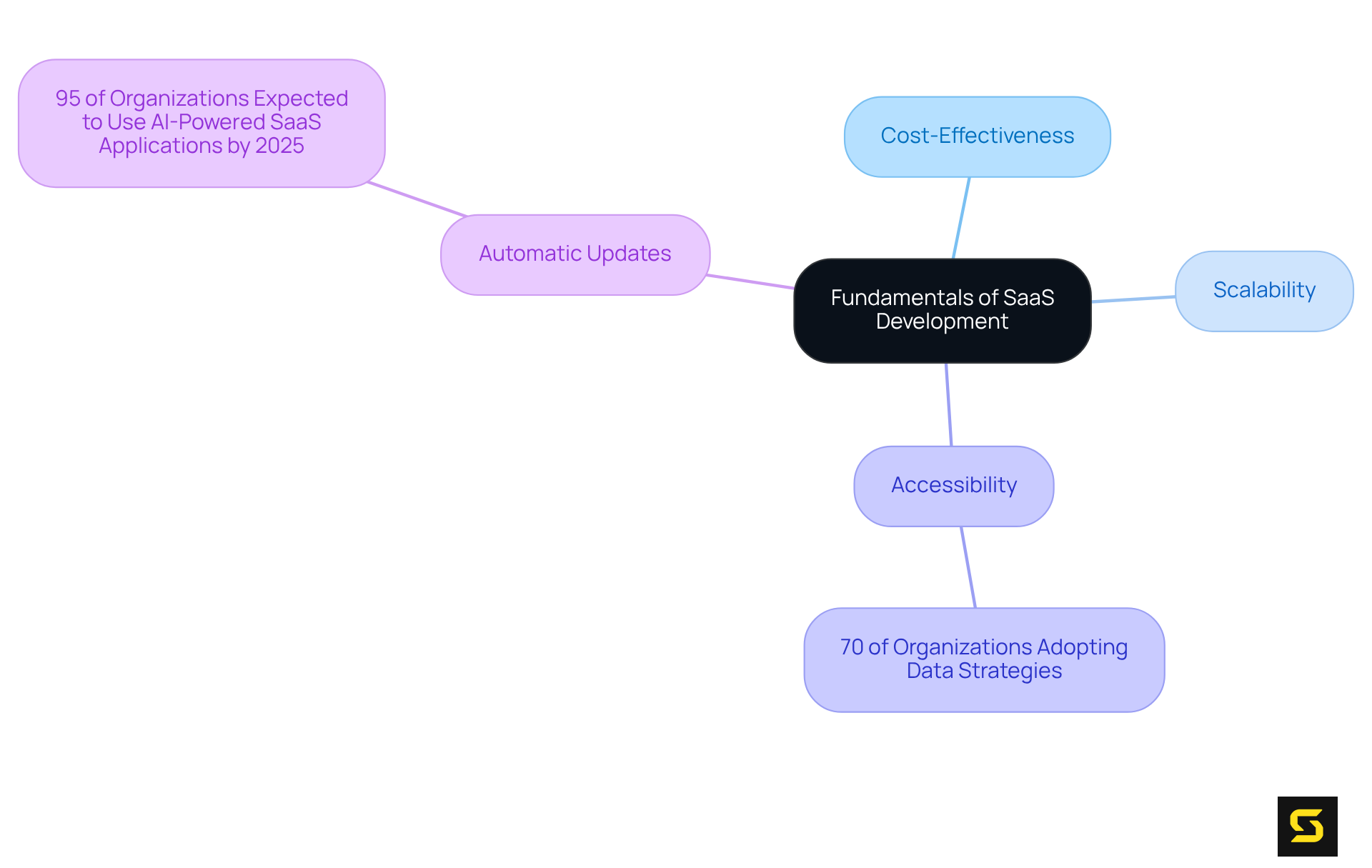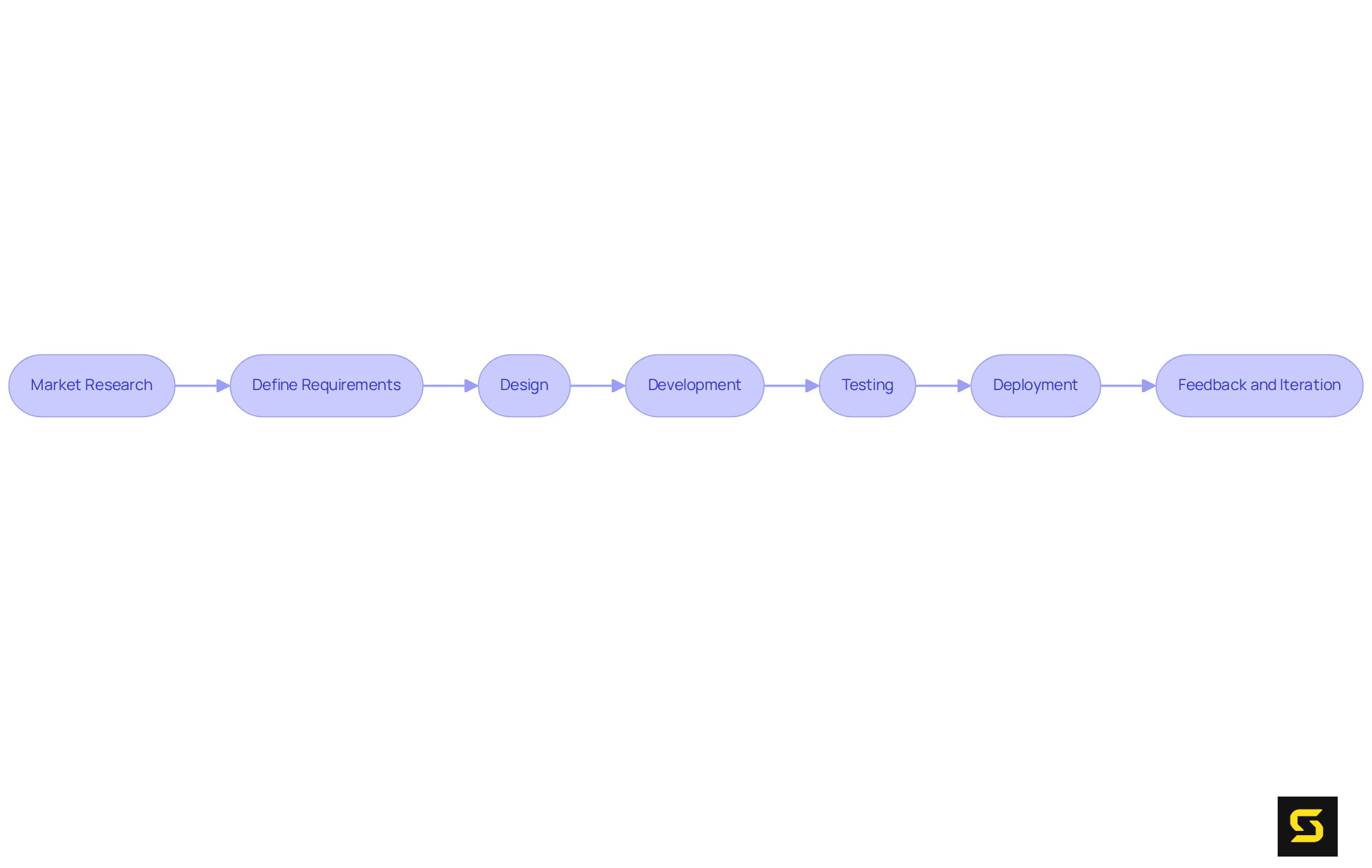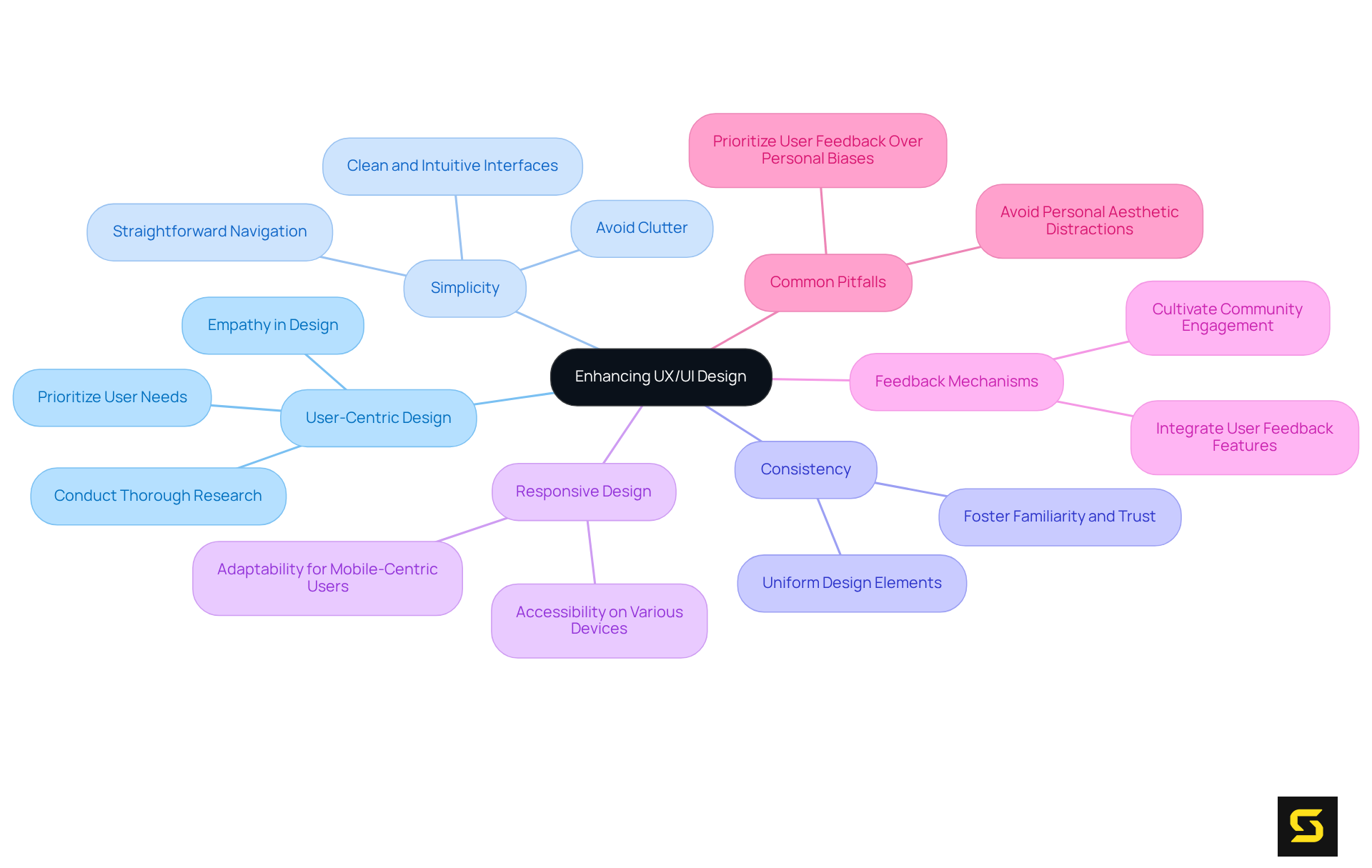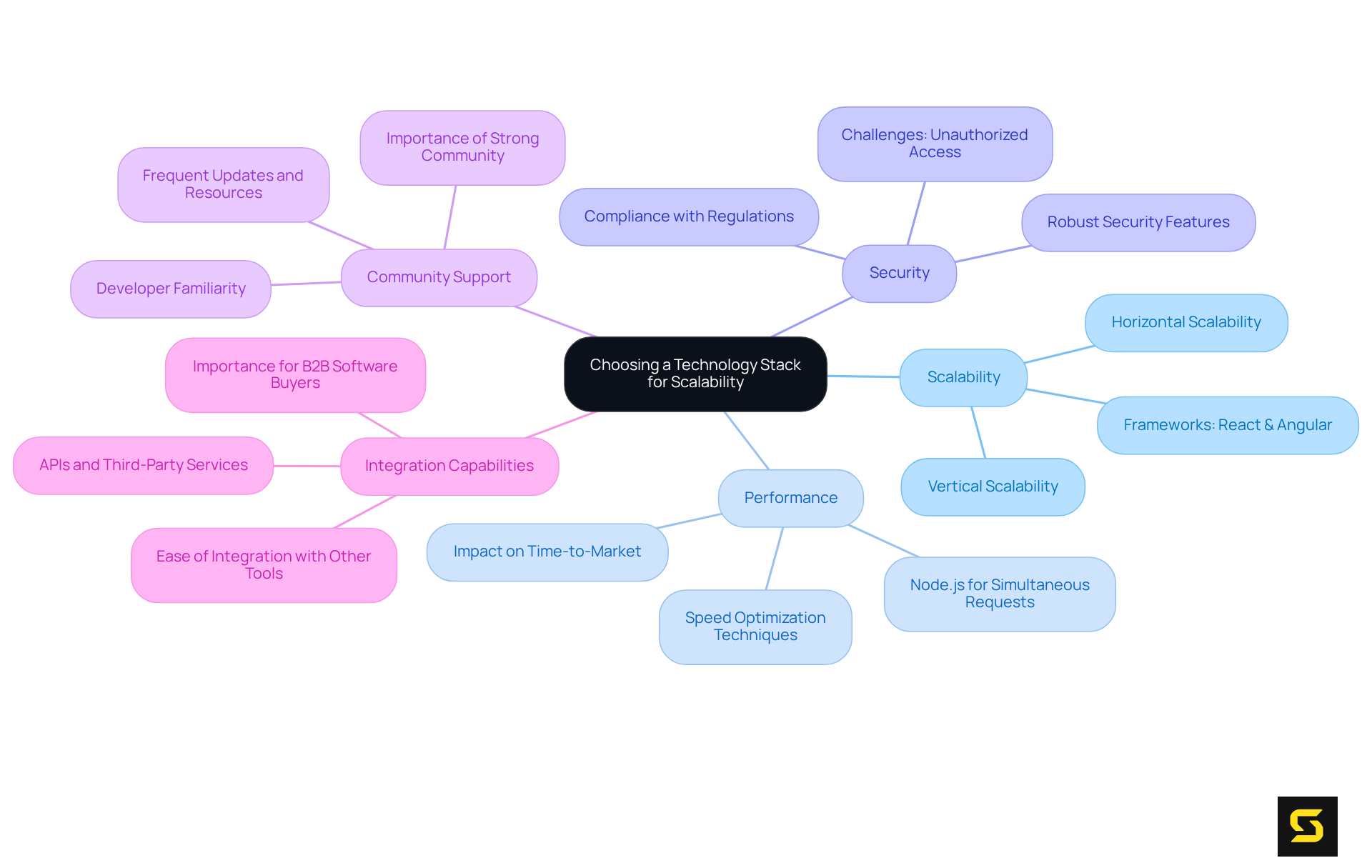Overview
Mastering SaaS app development is essential for success in today's competitive landscape. It requires a deep understanding of key practices such as:
- Market research
- User-centric design
- Selection of an appropriate technology stack
These elements are crucial for ensuring scalability and efficiency in your applications.
Market research allows developers to identify and respond to user needs, while user-centric design enhances engagement and satisfaction. Furthermore, choosing the right technology stack can significantly impact operational success by facilitating seamless growth and adaptability.
Incorporating these practices not only meets market demands but also drives innovation and operational excellence. As you navigate the complexities of SaaS development, prioritize these strategies to position your application for success. Engage with experts who can guide you through this process and elevate your SaaS offerings to new heights.
Introduction
The landscape of Software as a Service (SaaS) is evolving rapidly. This transformation is driven by the increasing demand for cloud-based solutions that offer flexibility, cost efficiency, and seamless accessibility. For product owners navigating this dynamic environment, understanding the key practices of SaaS app development is not just beneficial; it is crucial.
This article delves into essential steps:
- Aligning development strategies with market trends
- Prioritizing user experience
- Selecting the right technology stack
However, as the market grows, the challenges also intensify. How can product owners ensure their applications not only meet current demands but also anticipate future needs? This question is vital for maintaining a competitive edge in an ever-changing market.
Understand the Fundamentals of SaaS Development
Software as a Service (SaaS), a cloud-based software delivery model, empowers users to access applications via the internet. Unlike traditional software that necessitates installation on individual devices, cloud-based applications are hosted online, facilitating effortless access from any internet-connected device. The advantages of SaaS are compelling:
- Cost-Effectiveness: By reducing the need for extensive hardware and ongoing maintenance, SaaS significantly lowers operational costs for businesses.
- Scalability: SaaS solutions can easily scale to meet the demands of a growing clientele and increasing data needs, making them suitable for enterprises of all sizes.
- Accessibility: With programs accessible from any location, SaaS encourages remote work and enhances collaboration among teams. This is particularly pertinent as 70% of organizations are projected to adopt small and wide data strategies to bolster AI capabilities by 2025, underscoring the necessity of effective data management.
- Automatic Updates: Providers manage updates and maintenance, ensuring users benefit from the latest features without interruption. This is vital in an environment where 95% of organizations are expected to embrace AI-driven software applications by 2025, highlighting the advancing capabilities of these solutions.
Furthermore, the anticipated total expenditure by end-users for SaaS is projected to reach $299 billion, reflecting a remarkable growth of 19.2% compared to 2024. This statistic emphasizes the economic viability and increasing importance of SaaS solutions in the market.
Understanding these fundamentals allows product owners to align their development strategies with market demands and consumer expectations, ultimately driving success in the competitive SaaS landscape. However, it is essential to remain vigilant about potential pitfalls, such as challenges related to shadow IT and security risks that may arise with SaaS adoption. Real-world examples, such as the rapid integration of AI in software solutions, illustrate how these benefits translate into operational efficiencies and enhanced user experiences.

Follow Key Steps in SaaS Application Development
The SaaS application development process is a critical journey that encompasses several key steps:
- Market Research: Understand consumer needs and market trends to identify opportunities.
- Define Requirements: Clearly outline the features and functionalities necessary for the software.
- Design: Develop wireframes and prototypes to visualize the user interface and experience.
- Development: Build the software using an appropriate technology stack.
- Testing: Execute thorough testing to identify and rectify bugs before launch.
- Deployment: Launch the software and monitor its performance.
- Feedback and Iteration: Gather input from users and continuously enhance the software based on insights.
Adhering to these steps ensures a comprehensive approach to SaaS app development, which mitigates potential issues and elevates customer satisfaction. This method not only enhances the quality of the final product but also positions your services as reliable and effective in the competitive SaaS landscape.

Prioritize UX/UI Design for Enhanced User Engagement
Experience for clients (UX) and interface (UI) creation are crucial in saas app development. To enhance UX/UI, consider the following key practices:
- User-Centric Design: Prioritize the needs and preferences of your target audience. Conduct thorough research with participants to inform decision-making. As Blake Ross aptly noted, a product's success is inextricably linked to its UX, underscoring that innovative technology must be user-friendly to achieve mainstream adoption.
- Simplicity: Maintain clean and intuitive interfaces. Avoid clutter to facilitate effortless navigation. Scott Belsky emphasizes that simplicity is vital for effective experiences, reinforcing the notion that simplicity often signifies brilliance in design.
- Consistency: Ensure uniform design elements across the platform to foster familiarity and trust. This consistency enhances user comfort and engagement with the product.
- Responsive Design: Guarantee that the application is accessible on various devices and screen sizes. This adaptability is essential in today's mobile-centric world, where simplicity can significantly influence customer retention.
- Feedback Mechanisms: Integrate features that allow users to provide feedback easily, cultivating a sense of community and involvement. This engagement can lead to continuous improvement based on audience insights.
- Common Pitfalls: Be vigilant against the distraction of personal aesthetic preferences, which can misalign with audience needs. Prioritizing feedback from users over personal biases is crucial for effective design.
By integrating these practices, you can achieve substantial enhancements in participant engagement and retention. According to the Design Value Index, companies that focus on aesthetics can experience up to 228% better performance, highlighting the economic benefits of quality design. By prioritizing UX/UI design in saas app development, product owners can significantly enhance user satisfaction and loyalty.

Choose an Appropriate Technology Stack for Scalability
Selecting the appropriate technology stack is a fundamental choice in SaaS app development. Consider the following critical factors:
- Scalability: Opt for technologies that can handle increased loads without compromising performance. Frameworks such as React and Angular are favored for their scalability. With the worldwide software-as-a-service market expected to expand considerably, the necessity for flexible solutions becomes paramount.
- Performance: Select tools that optimize speed and efficiency. For instance, Node.js is recognized for its excellent performance in managing simultaneous requests, which is essential as businesses utilizing software as a service can launch new services or products up to 40% quicker.
- Security: Ensure the stack includes robust security features to safeguard data and comply with regulations. Security incidents pose a significant challenge for software-as-a-service firms, rendering this a crucial factor in your selection process.
- Community Support: Choose technologies with strong community backing for better resources and troubleshooting. Technologies with a large community often receive more frequent updates and support, enhancing reliability.
- Integration Capabilities: Ensure the stack can easily integrate with other tools and services, enhancing functionality. Ease of integration has become a top priority for B2B software buyers, underscoring its importance in the selection process.
By carefully selecting a technology stack, product owners can enhance SaaS app development to build scalable and efficient applications that meet user demands and adapt to future growth. Avoiding common pitfalls, such as overlooking the importance of community support and integration, can significantly enhance the likelihood of successful outcomes.

Conclusion
Mastering SaaS app development is not merely an option; it is a necessity for product owners aiming for success in a competitive landscape. By understanding the core principles of SaaS and implementing best practices, stakeholders can create applications that not only meet market demands but also deliver substantial value to users. This approach ensures a competitive advantage in a rapidly evolving environment.
The article delineates several key steps in the SaaS application development process, underscoring the critical importance of:
- Thorough market research
- User-centric design
- Judicious selection of a technology stack
Prioritizing user experience through effective UX/UI design is paramount, as it directly influences user engagement and satisfaction. Furthermore, the choice of the right technology stack is essential for scalability, performance, security, and integration capabilities—factors that collectively contribute to the long-term success of the SaaS application.
As the SaaS market continues to expand and transform, the insights shared here serve as an invaluable guide for product owners seeking to adeptly navigate the complexities of development. Embracing these best practices not only enhances the quality of the final product but also fosters innovation and responsiveness to user needs. This proactive approach paves the way for sustained success in the competitive SaaS environment. Therefore, taking decisive steps today is crucial for securing substantial advantages tomorrow, making it imperative for product owners to remain informed and adaptable in their strategies.
Frequently Asked Questions
What is Software as a Service (SaaS)?
Software as a Service (SaaS) is a cloud-based software delivery model that allows users to access applications via the internet, eliminating the need for installation on individual devices.
What are the main advantages of SaaS?
The main advantages of SaaS include cost-effectiveness, scalability, accessibility, and automatic updates.
How does SaaS reduce operational costs?
SaaS reduces operational costs by minimizing the need for extensive hardware and ongoing maintenance.
Why is scalability important in SaaS solutions?
Scalability is important because SaaS solutions can easily adjust to meet the demands of a growing clientele and increasing data needs, making them suitable for businesses of all sizes.
How does SaaS support remote work?
SaaS supports remote work by allowing programs to be accessible from any location, which enhances collaboration among teams.
What is the projected expenditure for SaaS by end-users?
The projected expenditure for SaaS by end-users is expected to reach $299 billion, reflecting a growth of 19.2% compared to 2024.
What role do automatic updates play in SaaS?
Automatic updates allow providers to manage updates and maintenance, ensuring users benefit from the latest features without interruptions.
What potential challenges should be considered with SaaS adoption?
Potential challenges with SaaS adoption include issues related to shadow IT and security risks.
How is AI expected to impact SaaS by 2025?
By 2025, 95% of organizations are expected to embrace AI-driven software applications, highlighting the advancing capabilities of SaaS solutions.
Why is understanding SaaS fundamentals important for product owners?
Understanding SaaS fundamentals enables product owners to align their development strategies with market demands and consumer expectations, driving success in the competitive SaaS landscape.





